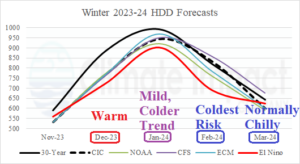Potential Complete Reversal in ENSO Phase by July/August 2024
11/27/2023, 2:46 pm ESTStratospheric Downward Wave Reflection Events
11/30/2023, 1:38 pm EST
Fig. 1: The Climate Impact Co. U.S. gas population weight HDD forecast for winter 2023-24 compared to the 30-year normal, latest CFS V2 and ECM forecast and the NOAA outlook. CFS, ECM, and NOAA HDD forecasts are estimates.
Discussion: November 2023 is likely to finish slightly warmer than a normal November El Nino month and moderately warmer than the 30-year normal. December 2023 forecasts are agreeably warm based on all models plus the CIC forecast and the warm El Nino climatology. Mid-winter is not quite as anomalous mild as December and the forecast trend is colder. The sensible forecast averages about halfway between warm El Nino climatology and the 30-year normal. In February, a warm finish to meteorological winter is typical of El Nino. However, the outlook is split between normally cold and slightly warmer than normal according to CIC and various forecast models. The month of March is agreeable…close to normally chilly.
El Nino winters are typically warm across the northern latitudes which lowers considerably the risk of arctic air evolution in Canada and outbreaks into the U.S. For this reason, El Nino HDD patterns are usually very warm. Additionally, the typical warm bias of El Nino covers the high demand Northeast U.S. also helping to bias U.S. HDD quite warm. Southern latitudes are chilly due to an energetic storm track which generates locally cold weather (and snow). However, the Southern chill has difficulty offsetting the strong warm bias in the North and especially the Northeast States.
The outlook provided by Climate Impact Company indicates above normal risk of cold weather for JAN/FEB. Cited is increased risk of negative North Atlantic oscillation (-NAO) which could cause moderately strong (and brief) polar vortex events that generate cold weather in the U.S. with the greatest risk in February. Note that if these events fail to form, the forecast is likely much warmer.
